Why do light spots appear on tomato leaves: determine the cause and save your harvest
In addition to providing favorable conditions for growing tomatoes, you should learn to recognize possible plant diseases. The most common sign that something is wrong with your tomatoes is the appearance of various types of spots on the leaves. You will learn what should be done in this case and how to deal with other tomato diseases from our article.
Determining the cause
How to understand that a plant is affected by some kind of disease? Quite simply: it begins to become covered with white and yellow spots.
If you recently moved your tomato plant to another location or watered it too much, symptoms of infection may appear.. The plant takes on an unhealthy appearance: spots appear on the leaves, the stems wither and dry out, and the fruits darken. The spots may form along the edges or in the middle, resemble a mosaic pattern, or appear in the upper and lower parts of the leaf.
If you notice any of these signs, the disease may have begun to develop.
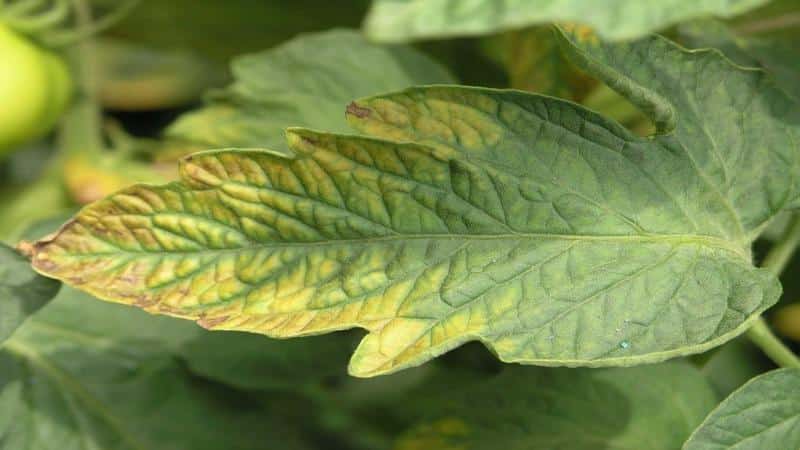
Dry spotting, or Alternaria blight
This disease is caused by fungi of the genus Alternaria. The disease affects many plants, so you should know how to deal with it.
Important! Alternaria blight is dangerous because its spores are quickly transferred by wind, raindrops and insects to healthy plants. The disease can destroy about 50% of the harvest of vegetables and fruits during the season.
In tomatoes, this disease is often called dry (or zone) spot.The disease is dangerous for all plants of the nightshade family and appears immediately after planting seedlings.
The entire upper part of the plant is affected: leaves, stems and fruits. The main sign that a tomato is infected with Alternaria is the appearance of clear, dry gray-brown round spots. Damaged leaves quickly turn yellow and fall off, and the fruits die.
To protect the plant from disease, it is recommended to treat its leaves and stems with Trichodermin in April and May. Do this when symptoms are already noticeable.
Spraying with Quadris (0.04-0.06%) is also effective when new symptoms appear. To protect fruits from Alternaria blight, spray tomatoes with a 0.4-0.5% solution of Acrobat MC or Ordan (2.5-3 kg/ha). If you plant a plant in open ground, then use “Sectin Phenomenon” (1-1.25 kg/ha), “Ridomil Gold MC” (2.5 kg/ha), “Acrobat MC” (2 kg/ha), "Metaxil" (2.5 kg/ha), "Poliram" (2.5-3 kg/ha), "Ordan" (2.5-3 kg/ha), "Cumulus" (2-3 kg/ha ).
In the photo you can see the consequences of damage by Alternaria.
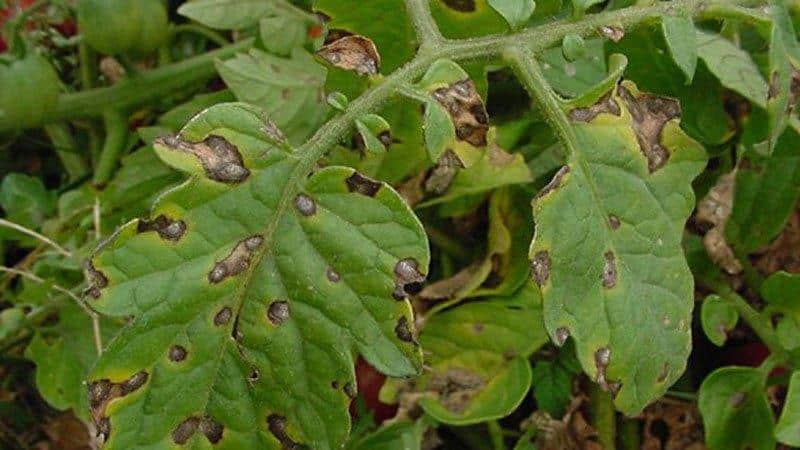
Burns from ultraviolet radiation and mineral fertilizers
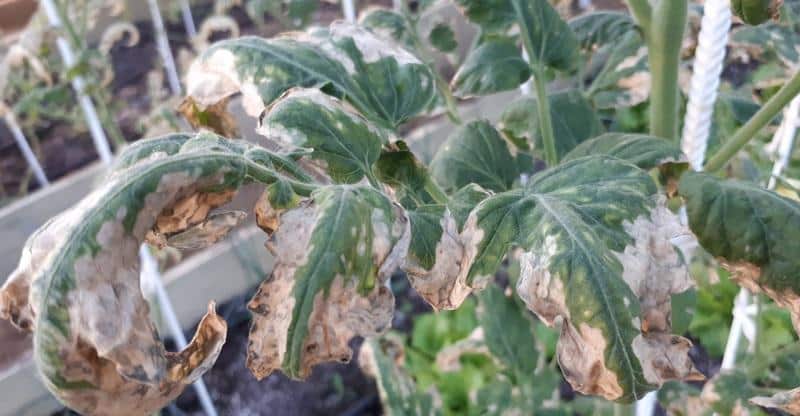
In summer, when it is especially hot outside, tomatoes can get sunburned. Then white spots appear on the fruits and leaves of the plants. Tomatoes stop growing, become hard, disproportionate in shape and tasteless.
To protect plants from burns, try to cover them in the shade in hot weather - to do this, use any material that prevents direct sunlight.
You can also burn tomatoes with mineral fertilizers. It is not recommended to buy drugs with a high nitrogen content. If you notice burns, use only half the solution.
Cladosporiosis
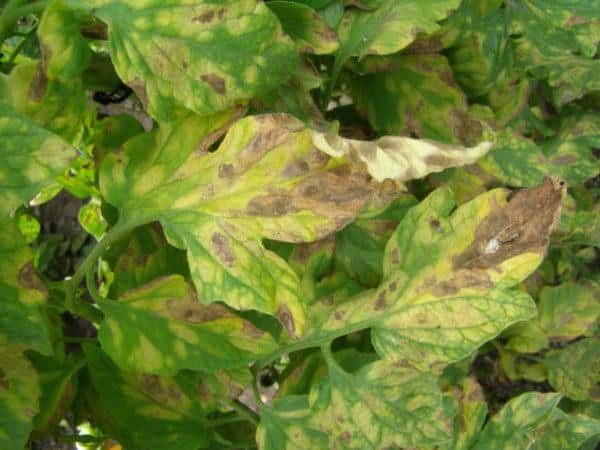
Brown olive blotch, or cladosporiosis, is a fungal disease primarily found in greenhouses. First, the lower leaves are affected, then round yellow spots appear on the surface, which later become one large spot.
A plaque forms on the bottom of the leaf - this is the appearance of fungal spores. As a result, the leaves begin to hurt, curl, and then die. The disease usually appears at the beginning of flowering or when fruit begins to set. It is believed that the earlier the disease appears, the more dangerous it is. A favorable environment for fungal growth is high humidity, long daylight hours and low light levels.
Most often, only the stems and leaves of the plant are affected; fruits are rarely infected. If this does happen, the tomatoes acquire a dark brown color and become soft, and subsequently dry out.
Reasons why the disease may appear:
- watering with cold water;
- sudden change in temperature;
- constant dampness.
Before medicating plants, remove all damaged leaves.
To cure the plant, it is necessary to use medicines containing copper: for example, "Bordeaux mixture"", "Barrier", "Barrier".
White coating on tomato leaves - powdery mildew
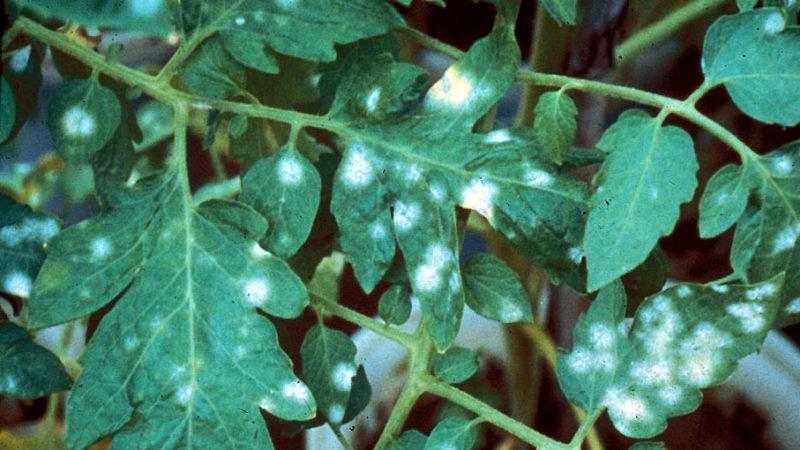
Powdery mildew (ash, white) is a fungal disease, the signs of which can be seen in the upper part of the leaves: a grayish-whitish coating that forms on seedlings and already mature plants. The mycelium of the fungus multiplies when spores mature and liquid begins to appear on the leaf blades.
The disease affects young shoots and fruits. Symptoms first appear at the bottom of the plant, and then along the entire length.When the fruit is infected, cracking and rotting are considered signs of infection, as infection gets into the cracks.
The flowers begin to turn black and brown spots appear on the tomatoes. Infected fruits are initially hard and then become soft.
When tomatoes are infected with powdery mildew, you can lose half of your harvest, so it is necessary to promptly respond to the symptoms and treat the infection. To combat, you can use chemicals - fungicides or folk remedies, which are no different in effectiveness from chemical ones.
Soda-soap solution
To prepare 5 liters of product, you will need the same amount of hot water, 25 g of soda and 5 g of soap. Treat the solution not only to the affected plants, but also to the soil. Before this, the solution is cooled. To combat powdery mildew, it is necessary to repeatedly treat plants at intervals of 2-3 days.
Potassium permanganate solution
This remedy is known for its antibacterial and antifungal properties. To get rid of powdery mildew on tomatoes, you need to use a solution prepared according to this recipe: add 2.5 g of permanganate to 10 liters of water and mix. Use every five days.
Tomatoes can also develop a disease such as septoria. Its main symptom is leaf damage. They are painted dark and saturated with moisture.
When the infection affects the stem, the spots become oval rather than round. At the last stage, the leaves dry out. As a result of this, the bush dies.
When a plant is affected by an infection, it is necessary to immediately begin to fight it. Use chemicals for treatment. Choose fungicides "Revus" and "Thanos". Breed them according to the instructions: 0.5 liters of Revus per 1 hectare, about 600 g of Thanos per 1 hectare.
Read also:
A guest in the garden, named after a star: the Canopus tomato.
Bright appearance and rich taste - the Golden Heart tomato.
Capricious to care for, but loved by summer residents, the “Pink Flamingo” tomato.
Leaf mold or brown spot
Leaf mold most often forms on plants growing in greenhouses.
This disease manifests itself primarily on the leaves and does not pose a threat to other parts of the plant. The disease proceeds from the bottom up: an olive coating begins to be visible in the lower half, and yellow spots appear in the upper part. They damage the surface of the leaves all the way through. Then the spots turn brown and acquire a dark brown color. Afterwards, the disease rises to the top, and the dried leaves begin to fall off. Favorable temperature is 20-25°C, if the air humidity is at least 90%.
Control measures:
- The disease can be stopped by immediately removing infected leaves.
- Treatment with copper oxychloride (0.4%) once every 10 days gives good results. Treatment should be stopped a month before harvesting.
- In greenhouses, air humidity should not exceed 60%. Sudden temperature fluctuations must be avoided.
Fomoz, or Phoma rot
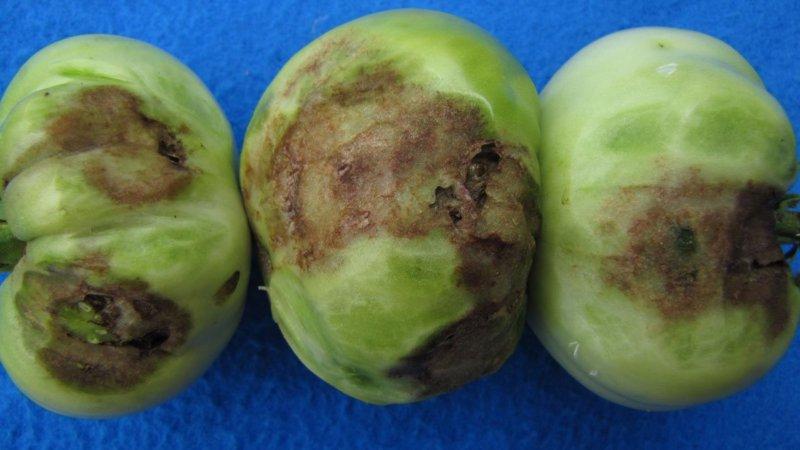
The disease affects the entire upper part of the plant. Small dark brown spots appear on the leaves, on which concentric rings can be seen.
Dark brown infected areas with concentric circles appear on the stems. Green and ripe fruits are also affected.
The disease remains in the ground, in plant debris, and also on closely related plants. The infection is easily spread by raindrops and even workers' clothing.Low concentrations of nitrogen and phosphorus in the soil also contribute to an increase in the spread of disease in plants.
Daily spraying with fungicides, improved sanitation, and removal of weeds like nightshade will reduce the severity of the infection. Avoid damaging the plant when harvesting dry fruits to reduce the spread of infection.
Nutritional deficiencies
Fungus and infection may not always be to blame for the sickly appearance of tomatoes. In many cases, light spots on tomato leaves, dryness and low plant growth may be due to a lack of nutrients.
You need to find out what exactly is missing. Nutrient deficiency can be determined by looking at the plant.
Potassium deficiency - with a lack of potassium, young leaves curl, and old ones turn yellow and gradually dry out. Tomatoes need to be treated with regular watering (one plant should require at least 0.5 liters of solution, which is prepared from 5 liters of water and 1 tsp of potassium nitrate) and spraying with solutions containing potassium (2 liters of water and 1 tbsp. potassium chloride).
Nitrogen deficiency - the leaves of the plant first dry out at the edges, and then turn yellow and fall off. The bush grows, the leaves look limp and pale, and the stem becomes unstable and soft.
To replenish vitamins, apply nitrogen-containing fertilizer. Water each bush with a solution of 5 liters of water and 1 tsp. urea.
Zinc deficiency can be identified by brown spots on leaves that curl upward, as well as small yellow spots. Tomato development is slowing down.
In this case, you should fertilize the plant with a solution containing zinc. You will need 5 liters of water and 2-3 g of zinc sulfate.
Molybdenum deficiency - the color of the foliage becomes lighter and turns yellow. The edges begin to curl. It is necessary to feed the plant with 5 liters of water per 1 g of ammonium molybdate (0.02% solution).
Phosphorus deficiency - the whole plant first turns dark green and then turns completely purple. In this case, the leaves begin to curl inward or rise strongly upward.
Fertilizer with phosphorus is prepared from 2 liters of boiling water and 2 glasses of superphosphate, then left overnight. Before watering, add 5 liters of water for every 0.5 liter of solution.
Anthracnose
The infection is caused by several pathogens of the genus Colletotrichum. Some infect fruits, others infect vegetative organs.
Anthracnose of tomato leaves already affects adult plants. The top leaves wilt first. Small black sclerotia appear on infected areas.
The places where the spores are located stretch along the stem or are located in groups of brown color: conidia measuring 15.2-22×3-5 microns, cylindrical or club-shaped with small rounded ends.
When tomato fruits have anthracnose, soft or depressed spots appear on the plant that do not differ from the color of the fruit.
Tomato varieties resistant to anthracnose are LSL hybrids F1 Life, Shelf, Longf. To combat it, it is effective to soak the seeds in a solution of one of the drugs: “Agat-25” (consumption 7 g/kg), “Immunocytophyte” (consumption 2 ml/kg). It is better to treat plants with the drug “Novosil”, and seedlings at the stage of 2-3 leaves with a solution of the drug “Agat-25” (consumption 14 g/ha).
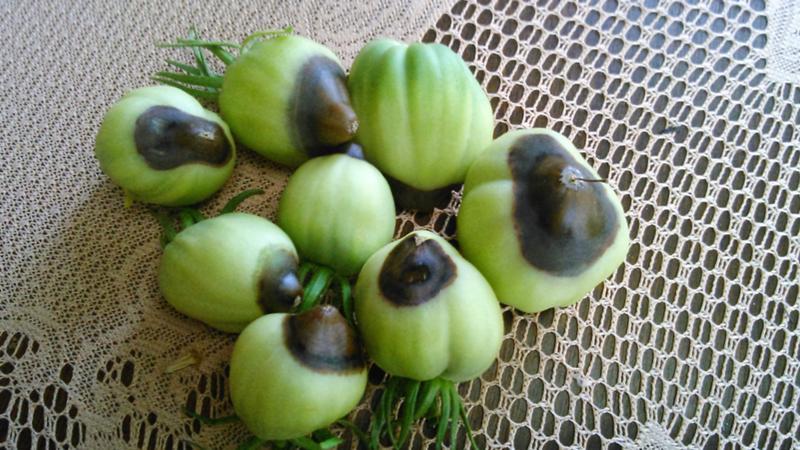
Mosaic virus
Mosaic is a viral disease. The infection is very difficult to treat. All you can do is take preventive measures. Seeds should be treated before planting. It is useless to treat infected plants.
The leaves of infected plants become variegated and have a mosaic coloring: alternating dark and light green areas. Yellow spots sometimes appear on the tomatoes themselves. If your tomatoes become infected with this disease, you will need to remove them.
Tomatoes grown in open ground suffer from mosaic disease. The main source of infection is infected seeds. For prevention, they must be treated before planting.
Reasons typical for tomatoes in a greenhouse
Preventing tomato infections in your greenhouse is important before you even plant them. Buy peat soil mixture in stores. You can find special peat pots - seedlings are grown in them and then planted in a greenhouse.
Many summer residents do not use pots, but collect soil in parks and under trees. And then various additives are added to it, which makes the plant more susceptible to infections.
Also, in addition to poorly prepared soil, there are a number of reasons why tomatoes are susceptible to infections: improper watering and sudden changes in soil moisture, untimely fertilizing, lack of nutrients and other microelements, various diseases of fruits and stems.
In the open ground
There are many reasons for tomatoes becoming infected and fruit rotting. These may include poor care, unfavorable environment, climate and others.
In addition to infectious diseases - blossom end rot, late blight, fusarium and others - the causes may be:
- lack of moisture;
- lack of magnesium and boron in the soil.
Important! Since rot spreads instantly, you should carefully inspect the bushes so that at the first sign you can begin to fight the disease.
How to save a plant
Every gardener should know that it is easier to stop an infection than to treat it. You can protect the plant by adhering to the following recommendations:
- Choose tomato varieties that are resistant to fungus.
- Treat seeds before planting with a 1% solution potassium permanganate or copper sulfate.
- Inspect the crops growing nearby, especially potatoes.
- Create living barriers of legumes near tomatoes to prevent the transfer of fungal spores.
You also need:
- ventilate the greenhouse daily;
- moderately moisten the soil;
- rarely plant tomatoes;
- remove the surface of last year's humus.
Preventive measures
To prevent plants from becoming infected with diseases, they must be grown according to the following rules:
- First you need to choose the right variety. For greenhouses, you can take indeterminate varieties. In the fall, take the Ural multiple fruit variety. In the spring, choose Leningrad early ripening.
- If the yield of your varieties depends on the weather, plant several hybrids.
- Use soil similar to greenhouse soil.
- Water regularly, but moderately.
- Tomatoes love light.
- Feed the plants periodically.
- Tomatoes are often affected by fungal diseases, so several treatments should be carried out.
There are many infections that affect tomatoes. Tomato diseases can be successfully treated, but it is best to carry out prevention before planting.
Tips and tricks
Here are some more useful tips:
- Plant tomatoes away from potatoes.
- Grow tomatoes in greenhouses - this limits the spread of infections.
- Water the plants in the morning.
- Avoid breaking and cutting the plants.
- Remove all plant debris and dig the soil to a depth of 20 cm.
- Maintain crop rotation.Do not plant tomatoes in the same place.
Conclusion
Now you know everything about the most common diseases and infections of tomatoes. Always select plant varieties that suit your climate and growing environment, treat the seeds and soil - this is good disease prevention. Try to maintain a regular schedule of watering your plants. Take care of your tomatoes so that they please you with a rich and tasty harvest.